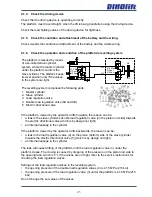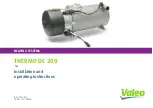
31
4.3.1.
Inspect thoroughly the support outriggers and the outrigger cylinder joints
Check the mechanical structure of the outriggers and the welded seams.
The structures must not show signs of deformations or cracks. No fractures or cracks are
allowed in the welded seams.
Check the footplates for deformations, cracks or breaches
Also check that the footplate can turn freely on its joint.
Check the condition of the outrigger joints:
1. lower the outriggers slightly
2. swing the outriggers back and forth in the
horizontal plane and check the joints for play
3. check the operation and condition of the limit
switch mechanisms on the outriggers
4. replace any worn out parts
5. lubricate the outrigger joints (see point
“Lubrication plan”)
Lower the outriggers to the support position.
4.3.2.
Check the frame structures, the boom system, the work platform and the
platform carrier
Check the condition of the chassis
• general condition
• check the attachment of the tow-bar to the chassis
• check the condition of the overrun and its attachment to the chassis.
• check the rims, the tightness of the wheel bolts, the tyres and the tyre pressures. The
correct pressures are marked on the wheels and on the jockey wheel bracket.
• check the condition of the transport support of the boom
Inspect the boom
• extend the telescope and check that there are no permanent deformations, dents or
traces of substantial wear in the boom
• check the welded seams for wear, cracks or breaches
• check the boom attachment for cracks or breaches
• inspect the boom joints, the sliding pads and their play – readjust if necessary. Lubricate
the sliding surfaces
• check the condition of the cable chain, its clamp brackets as well as the tightness of the
screw connections
• check the condition of the platform brackets
• check the locking of the platform pin
Inspect the work platform
• general condition
• check that the platform does not show signs of deformations, substantial wear or buckles
• check that the handrails, the steps, the gate and the attachment of the gate are in order
• check that the lock of the gate and the gas spring are in order
•
check the condition of the platform floor plate
• check the platform carrier for notable buckles or deformations
Summary of Contents for DINO 160XT II
Page 2: ......
Page 19: ...19 6 9 7 11 7 8 1 5 5 3 2 12 3 4 10 13 2 2 LUBRICATION PLAN 14...
Page 79: ...79...
Page 80: ...80 Maintenance instructions DINO 160XT II 180XT II 210XT II...
Page 81: ...81...
Page 82: ...82 Maintenance instructions DINO 160XT II 180XT II 210XT II...
Page 83: ...83...
Page 84: ...84 Maintenance instructions DINO 160XT II 180XT II 210XT II...
Page 85: ...85...
Page 86: ...86 Maintenance instructions DINO 160XT II 180XT II 210XT II...
Page 87: ...87...
Page 88: ...88 Maintenance instructions DINO 160XT II 180XT II 210XT II...
Page 89: ...89...
Page 90: ...90 Maintenance instructions DINO 160XT II 180XT II 210XT II...
Page 91: ...91...
Page 92: ...92 Maintenance instructions DINO 160XT II 180XT II 210XT II...
Page 93: ...93...
Page 94: ...94 Maintenance instructions DINO 160XT II 180XT II 210XT II...
Page 95: ...95...
Page 96: ...96 Maintenance instructions DINO 160XT II 180XT II 210XT II...
Page 97: ...97...
Page 98: ...98 Maintenance instructions DINO 160XT II 180XT II 210XT II...
Page 99: ...99...
Page 100: ...100 Maintenance instructions DINO 160XT II 180XT II 210XT II...
Page 101: ...101...
Page 102: ...102 Maintenance instructions DINO 160XT II 180XT II 210XT II...
Page 103: ...103...
















































